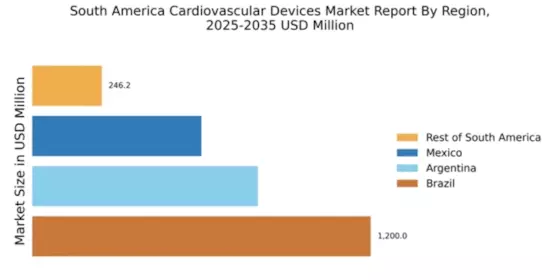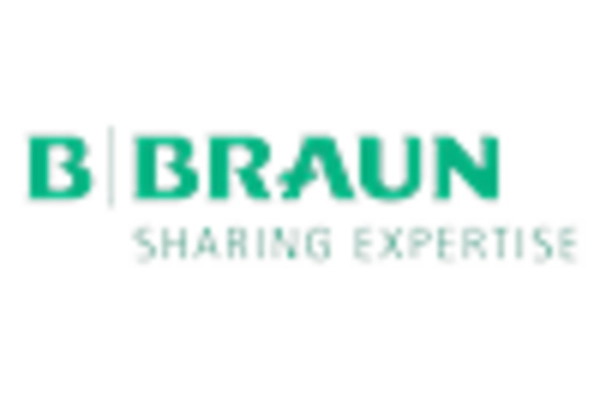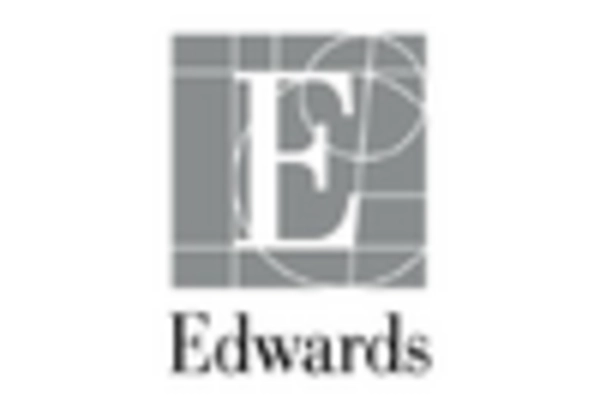Increasing Aging Population
The aging population in South America is a crucial driver for the cardiovascular devices market. As individuals age, the risk of cardiovascular diseases escalates, leading to a higher demand for medical interventions. In South America, the population aged 65 and older is projected to reach approximately 10% by 2030. This demographic shift necessitates advanced cardiovascular devices to manage age-related health issues. The cardiovascular devices market is likely to experience growth as healthcare providers seek innovative solutions to cater to this aging demographic. Furthermore, the increasing prevalence of comorbidities among older adults further amplifies the need for effective cardiovascular management, thereby driving the market for devices designed to address these complex health challenges.
Rising Healthcare Expenditure
Healthcare expenditure in South America is on the rise, which significantly impacts the cardiovascular devices market. Governments and private sectors are investing more in healthcare infrastructure, leading to improved access to advanced medical technologies. In 2023, healthcare spending in South America was estimated at around $1.5 trillion, with a notable portion allocated to cardiovascular care. This increase in funding allows for the procurement of state-of-the-art cardiovascular devices, enhancing patient outcomes. The cardiovascular devices market is poised to benefit from this trend, as hospitals and clinics upgrade their facilities to meet the growing demand for effective cardiovascular treatments. Enhanced funding also facilitates research and development, potentially leading to innovative devices that could further transform patient care.
Technological Integration in Healthcare
The integration of technology in healthcare is transforming the cardiovascular devices market in South America. Innovations such as telemedicine, remote monitoring, and artificial intelligence are enhancing patient care and device functionality. For instance, remote monitoring devices allow healthcare providers to track patients' cardiovascular health in real-time, leading to timely interventions. The cardiovascular devices market is likely to expand as these technologies become more prevalent, improving patient outcomes and reducing hospital readmission rates. Additionally, the collaboration between tech companies and healthcare providers is fostering the development of cutting-edge devices that cater to the specific needs of the South American population, potentially revolutionizing cardiovascular care.
Growing Awareness of Preventive Healthcare
There is a notable increase in awareness regarding preventive healthcare in South America, which serves as a significant driver for the cardiovascular devices market. Public health campaigns and educational initiatives are encouraging individuals to adopt healthier lifestyles and seek regular health check-ups. This shift towards preventive care is likely to result in earlier detection of cardiovascular conditions, thereby increasing the demand for diagnostic and therapeutic devices. The cardiovascular devices market may see a surge in the adoption of devices such as blood pressure monitors and cholesterol testing kits as individuals become more proactive about their health. This trend not only enhances patient engagement but also fosters a culture of prevention, which is essential for reducing the burden of cardiovascular diseases in the region.
Regulatory Support for Medical Innovations
Regulatory bodies in South America are increasingly supportive of medical innovations, which positively influences the cardiovascular devices market. Streamlined approval processes and incentives for research and development are encouraging manufacturers to introduce new devices. In recent years, several countries in the region have implemented policies aimed at expediting the approval of life-saving cardiovascular technologies. This regulatory support is likely to enhance the cardiovascular devices market by facilitating quicker access to advanced treatments for patients. Moreover, as regulations evolve to accommodate emerging technologies, manufacturers may be more inclined to invest in the development of innovative cardiovascular devices, ultimately benefiting patient care and health outcomes across South America.


















Leave a Comment